Between
Bodies, October 2008-April 2009
An interactive sound installation by Nina Waisman
CECUT, Tijuana
An interactive sound and sculpture installation for the entrance hall
of the new International Wing of the Centro Cultural Tijuana. The
installation is part of the show Proyecto Cívico, curated by Lucía Sanromán
and Ruth Estévez.
Here is some rough documentation video shot by Patricia Montoya:
Between Bodies, short version (2.5 minutes)
Between Bodies,
video (4 minutes)
videoography: Patricia Montoya
visitors, in order of appearance: Tambor Tamborini, Mely Barragan, Jennifer
Donovan.
Here
are links to articles on the piece and on Proyecto Civico:
Projecto
Civico Review on LatinArt.com
Make
Some Noise on San Diego CityBeat
Proyecto Cívico and the new wing of the CECUT
Between Bodies developed out of an invitation I received from
curators Lucía Sanromán and Ruth Estévez to create a piece for Proyecto
Cívico, an inaugural show for the new international wing
of the CECUT in Tijuana. Among other potential sites, they offered
me the long, funnel-like hallway that is the new entrance to this
wing. This entrance was to be the first one facing the heart of the
city (the original entrance to the CECUT faces the US border). While
this seventy-foot long, low-lit, funnel-shaped descent into the museum’s main lobby seemed to suggest that a decisive distancing from Tijuana was the proper preparation for the museum experience, I became excited about the sonic potential of flipping this program, of bringing the city back into the passageway and heightening the visitors’ connections
to the rich mix of energies that make up Tijuana.
Between Bodies: Description
Between Bodies seeks to connect the visitor's actions to a wide range of bodily and sonic energies circulating through Tijuana, to make visceral the connections that passers-by have to the huge network of human agency at work in the city. The sounds triggered in the piece sample everyday gestures/communications encountered in the streets of the city. Many of these gestures are undertaken to generate civic services and spaces where there are none officially planned
or supported.
Starting from the street entrance (the wider side of the funnel),
a narrower but similarly funnel-like configuration of tubes and sensors
presents itself as a staggered “curtain” to the visitor. There is room to pass through this funnel of sensors, but they are angled so that it would be very hard to escape being seen by them, and thus generating sound in the space. The sensors here are spaced closely enough to encourage solo visitors to play more than one sound at a time. By using the torso for one sensor, and the hands, hips or legs for the adjacent sensors (this does not require unnatural contortions) visitors can create and modulate complex urban sound networks even if they are alone. By slowing down and wandering off from the architecture’s
dominant linear program, visitors gain access to more of the sonic map
of the city.
This first section of the installation focuses on rhythmic sounds of
constructive labor – sweeping, filing, typing, etc. The typing is that of Lourdes Luján, a community organizer/activist, using her keyboard to produce online documentation of toxic manufacturing practices in the maquiladoras of Colonia Chilpancingo. The sweeping sound is made by an older woman in an under-serviced neighborhood above Playas, sweeping up street rubble to prevent it being thrown by passing cars at unprepared pedestrians. The filing sound is made by a young man on Avenida Revolución, as he converts undervalued coins into pricier works of art by filing them into the forms of tourist mementos. Undercutting these rhythms are ambient neighborhood sounds, such as the sounds of roosters crowing in Maclovio Rojas, hundreds of roosters raised on disputed land, for cockfights, a sport/ritual of longstanding import in Mexico. The sources of the sounds are not declared in the space, but it is hoped that the diverse energies of this assertive productivity may be felt. If there are multiple visitors, they pass this entry “curtain” at the same time - creating networked re-compositions of the city’s
energy.
The next sensor-arrangement encountered encourages visitors to move off
to the side of the hallway. One person can “play” the circular enclosure at the end of this curve, or multiple people can engage with it at once. This changeable drawing (I think of these sensor arrangements as drawings) is filled mostly with sounds of people trying to get your attention in Tijuana – vendors
using bike horns, voice, music, bullhorn announcements, people calling
on last-generation phones, the sound of a replica of an ancient Aztec
flute.
The following S-shaped sensor-drawing also permits solo or multiple visitors
to create sound compositions. The sound here consists primarily of children
playing and working in the streets - jumproping, playing soccer, buying
ice cream, digging ditches, working in a market, and so on. The last
drawing, a simple C-curve, will capture most anyone passing by – i.e.
those entering from the lobby side, or from the street. This section
communicates with the main lobby and the Proyecto
Cívico show, and is focused on sounds of policing and control, undercut by sounds that complicate the power narrative.
When there are multiple visitors in the piece, they frequently unleash a chaotic avalanche of sound testifying to the potent mix of energies in the city.
In all sections, the sounds are triggered and changed by visitors’ movements. Pitch, speed, volume, spatialization and layering of the sonic components are variously changed in real time in relation to a visitor’s proximity to sensors. Movement at some sensors allows the dominant sounds to be undercut or replaced by sounds of a contrasting nature. Sensors are placed at different heights in relation to the visitors body; the area of sensitivity lies between 6” and 3’ in front of each sensor’s clearly visible “eyes”. An exploration of physical proximity to these sensors affords the visitor increased co-creative proximity with respect to the sounds of others’ recorded
gestures. Thus the encounter for visitors is one in which their bodily
gestures meet those of Tijuana residents. Moving towards the sensors,
gesturing, trying out just slight-out-of-the-ordinary moves, will allow
a visitor to experience and modulate sound generated by other bodies
in Tijuana, to sense and explore the sonic traces of an endlessly improvised
civic fabric.
From the Invitation to Proyecto Cívico:
"Proyecto Cívico investigates the reconfiguration of the notions
of civic responsibility and citizenship under political and social conditions
defined by exception to the rule of law. The exhibition departs from the recent
attention paid to the city as central theoretical model and site of study and
turns the focus towards those who inhabit the city, to all citizens and potential
citizens. ...Exceptions to the rule of law, however, also create vacuums that
are increasingly appropriated by individuals and groups as spaces of renewed
personal and communal possibility of social engagement and change."
Aritsts in Proyecto Civico / Civic Project:
Gabriel Acevedo Velarde, Francis Alÿs, Shoja Azari, Guy Ben-Ner, Andrea Bowers, Mircea Cantor, Raúl Cárdenas/Torolab, Fabián Cereijido, Sam Durant, Sergio de la Torre, Ingrid Hernández, Daniel Joseph Martinez, Bas Princen, Marcos Ramírez ERRE, Javier Ramírez Limón, Daniel Ruanova, Yvonne Venegas, Nina Waisman.
Project Credits for Between Bodies:
Interactive Sound Installation: Nina Waisman
PD programming: Marius Schebella
Guides/Translators in Tijuana: Jenny Donovan & Ingrid Hernández
Special Thanks To:
Lucía Sanromán for support of every kind; Carmen Cuenca, Tania Abril Castro, Selene Preciado Ramirez, Carlos Alberto Garcia Cortez and Felipe Zuñiga for generous logistical and finanacial support at CECUT; Luis Castro and Hortensia Hernández (community leaders and activists fighting for property and community rights in Maclovio Rojas), for their generous interviews and tours in Maclovio; Lourdes Luján (community organizer/activist against toxic manufacturing practices in the maquiladoras of Colonio Chilpancingo) for her generous interview; Jennifer Donovan, Gabriela Torres Olivares and Tambor Tamborini for their bubbly assistance with installation; Patricia Montoya, Mely Barragan, Jennifer Donovan, Gabriela Torres Olivares, Daniel Ruanova, Tambor Tamborini for their artistry in the video documentation; Jordan Crandall, Sheldon Brown, Jennifer Pastor, Miller Puckette, Amy Adler, Ricardo Dominguez Norman Bryson, BJ Barclay & Scott Richards for ongoing support throughout my time at UCSD; Pierre Galaud who selflessly offered his fabulous brains and body along the whole path of this project.
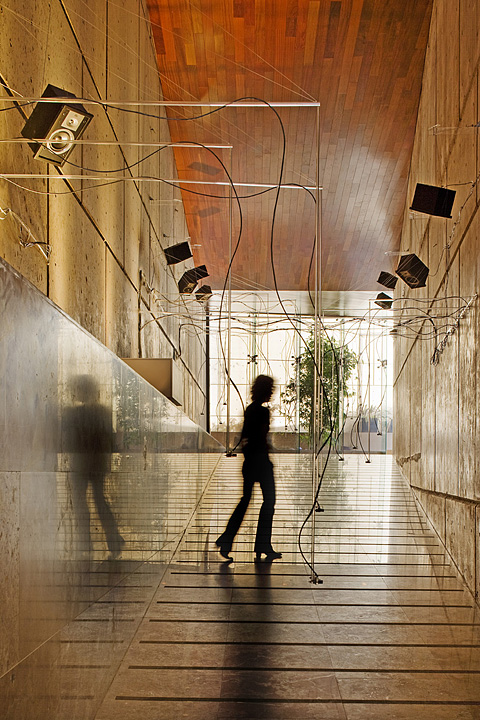
photo:
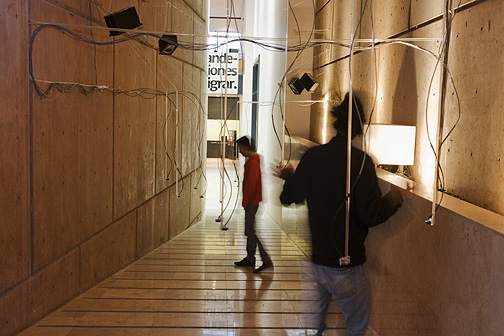
photo:
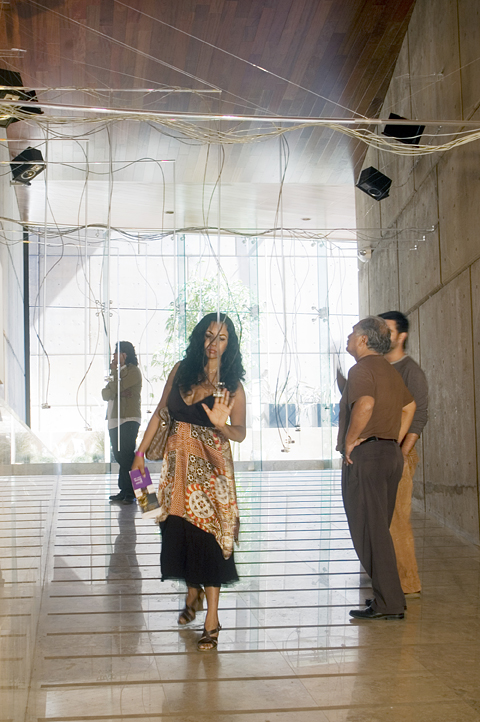
photo:
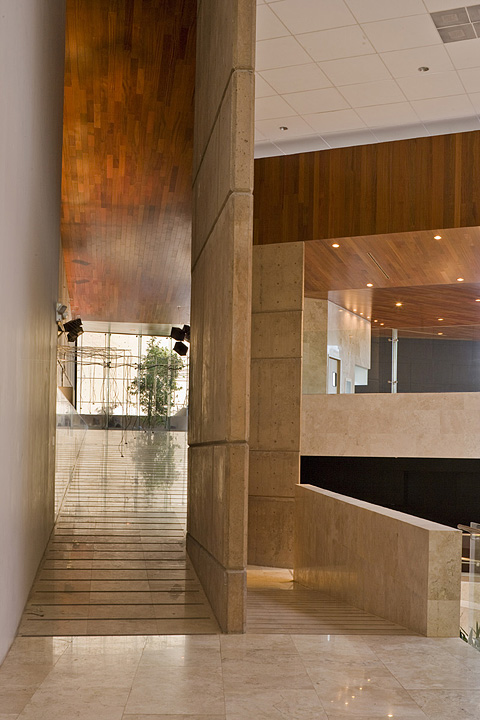
photo:
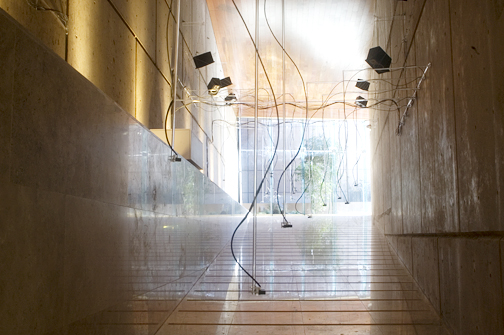
photo: